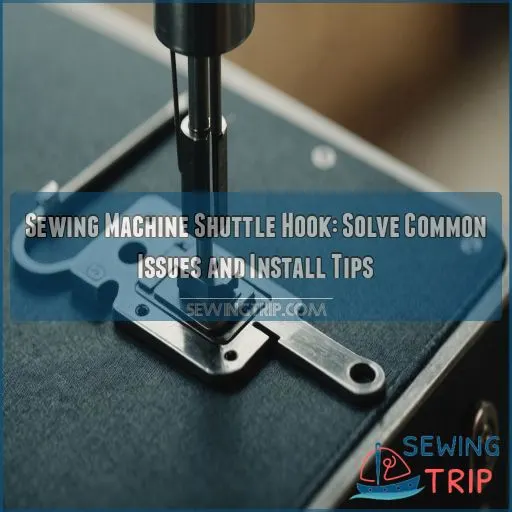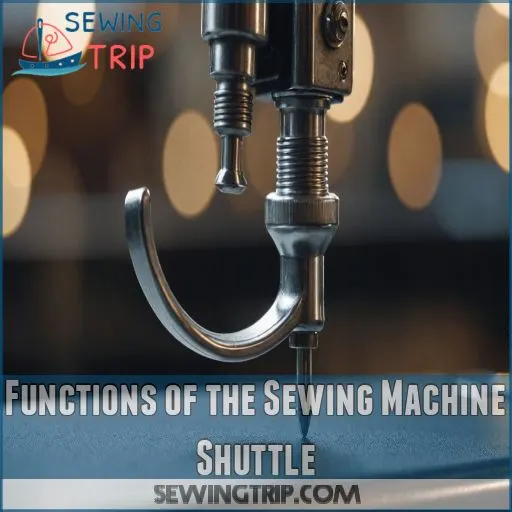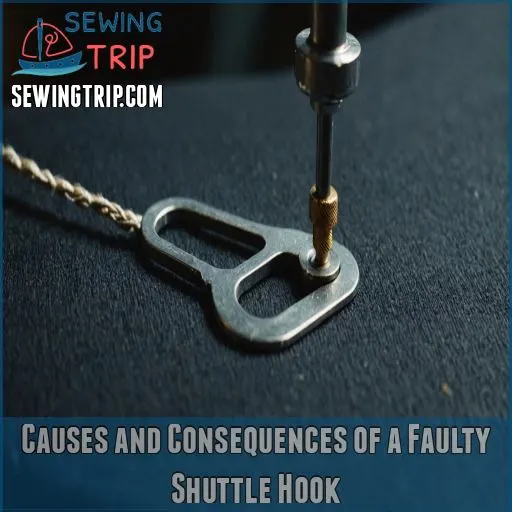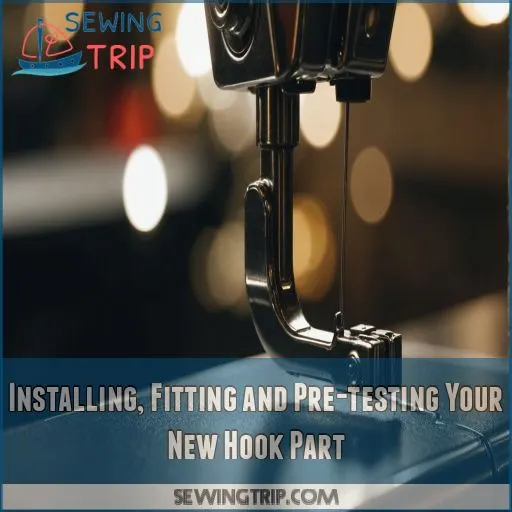This site is supported by our readers. We may earn a commission, at no cost to you, if you purchase through links.
 Ever wondered how your sewing machine creates those neat stitches?
Ever wondered how your sewing machine creates those neat stitches?
Meet the sewing machine shuttle hook, your unsung hero!
It’s like a well-choreographed dancer, catching the thread from the needle and swinging it around the bobbin like a graceful waltz.
This clever gadget makes sure your stitches are smooth and even, acting like a tiny conductor in a thread orchestra.
Whether metal (the robust, silent type) or plastic (a bit louder, but budget-friendly), the shuttle hook keeps your sewing symphony playing beautifully.
Stay tuned for tips on keeping your shuttle hook in tip-top shape, guaranteeing harmony in every stitch!
Table Of Contents
Key Takeaways
- Without the shuttle hook, your sewing machine would be as useful as a car without wheels. It’s the unsung hero that catches the needle thread and dances it around the bobbin to create those neat stitches you love.
- Choosing between a metal and plastic shuttle hook is like deciding between a sturdy old pickup and a zippy new scooter – metal is durable but pricey, while plastic is budget-friendly but noisier.
- Troubleshooting shuttle hook issues can feel like untangling a ball of yarn. Regular cleaning and alignment checks can keep it from turning your latest project into abstract art.
- Nearly 90% of sewing mishaps are shuttle hook-related. Keeping it in top shape is key to making sure your sewing machine runs smoothly and your stitches look professional.
Functions of the Sewing Machine Shuttle
You’ll find the shuttle hook to be a key part of your sewing machine as it works alongside the needle and thread to create precise stitches.
Whether you choose metal or plastic designs, each has its quirks, but the result should always be seamless and frustration-free stitches—unlike trying to untangle holiday lights.
What the Shuttle Hook Does
The shuttle hook is a really important part of your sewing machine, responsible for transferring the fabric to the needle and creating the stitch loop. Learn about the different types of sewing machine hooks. It works seamlessly with the thread and needle to create those perfect stitches. Think of it as the unsung hero – without it, your machine would be, well, a bit useless. Let’s take a look at what this little guy can do!
- Makes sure even and accurate thread cuts
- Facilitates smooth fabric movement
- Helps maintain proper thread tension
- Enables consistent stitch formation
- Contributes to overall sewing machine efficiency
Collaboration Between Shuttle, Needle, and Thread
Imagine you’re the maestro of a sewing symphony, orchestrating every detail. Ensuring proper thread tension and needle timing in harmony with bobbin interaction, your shuttle hook, and rotary hook can create a flawless stitch formation.
Keep this table handy to troubleshoot:
| Issue | Source | Solution | Tip |
|---|---|---|---|
| Misalignment | Shuttle Hook | Realign Shuttle | Check shuttle alignment regularly |
| Bunches Up | Thread Tension | Adjust Tension | Examine thread tension first |
| Timing | Needle Issues | Fix Needle Timing | Sync needle timing precisely |
| Tangling | Bobbin Issues | Correct Bobbin | Prevent tangling with proper setup |
Master these elements, and you’ll sew like a pro!
Comparison Between Metal and Plastic Shuttle Designs
When comparing metal and plastic shuttle designs, think of it as choosing between a trusty old car and a snazzy new ride.
Metal shuttles win on durability and maintenance ease, but they’re heavier and pricier.
Plastic is lightweight and cheaper, yet noisier.
Whether it’s the rotary hook for 2800 or shuttle hook for 3650hd, choose wisely!
Causes and Consequences of a Faulty Shuttle Hook
If your sewing projects look more like abstract art due to skipped stitches and tangled threads, your shuttle hook might be the culprit. This happens when your sewing machine is skipping stitches.
Let’s untangle the mystery: when the shuttle hook misbehaves, it gives your fabric a tough time but also puts your sewing machine on a permanent coffee break. If you’re experiencing skipped stitches, it could be a sign of a timing issue!
Common Shuttle Hook Issues
Uh oh, looks like your shuttle hook is giving you some trouble! Don’t worry, we’ve got your back.
First, check if the hook is binding or causing skipped stitches.
Timing issues, dirt buildup, and misalignment can all lead to these pesky problems.
Give that shuttle a good cleaning and make sure it’s properly aligned.
With a little TLC, you’ll have that machine humming like a well-oiled sewing machine in no time!
Impact of Faulty Shuttles
If you’ve struggled with skipped stitches or thread bunching, a faulty shuttle might be the culprit.
Without its smooth flow, you risk machine jamming, ruined sewing quality, and unexpected repair costs.
Materials pushing forward unevenly? Check the seam allowances and needle bar height since improper alignment could be making things wonky, leaving you, and your project, at wit’s end.
Troubleshooting Shuttle Hook Problems
Fixing shuttle hook issues feels like solving a puzzle.
First, try shuttle hook cleaning to free trapped threads.
Tackle tension woes with proper shuttle hook tension adjustments.
For wonky stitches, check shuttle hook alignment.
Swap out damaged parts for shuttle hook replacement.
Regular shuttle hook lubrication can smooth rotary operations, whether it’s on model 85017, 830, or 2700.
Happy sewing!
Installing, Fitting and Pre-testing Your New Hook Part
When you’re fitting a new shuttle hook into your sewing machine, it’s like piecing together a small jigsaw puzzle – rewarding when done right.
Take a deep breath, make sure everything aligns with a little twist and tweak, and soon you’ll be stitching like those YouTube sewing stars, minus the unintentional pin pricks!
Simple Initial Operating Mechanisms Evaluation
Before you install that new shuttle hook, give it a quick once-over.
Slide it in and out a few times – you want it to glide smoothly without any hiccups.
Spin the hook and make sure it rotates freely.
A properly fitted hook should feel just right, not too tight or too loose.
This simple test makes sure your machine is ready to sew like a dream.
Not a Professional Working
- Gently remove the faulty shuttle—think like diffusing a bomb, only less explosive.
- Check the model—grab your 85017, 2800-b, 1660, or 830 replacement.
- Fit the newbie shuttle part snugly in place.
- Test it—bond like old pals.
Frequently Asked Questions (FAQs)
What are the different types of sewing machine hooks?
From classic curved hooks to modern, precision-engineered designs, sewing machine shuttles come in a variety of types to suit different machines and fabric needs.
Sewing machine shuttles are designed for different fabrics.
Whether you’re stitching silk or denim, there’s a shuttle hook made just for you.
What are the different types of sewing machine shuttles?
There are various types of sewing machine shuttles, such as oscillating, rotary, and drop-in.
Each type has its own benefits and quirks, like an ensemble of sewing machine performers, ensuring smooth stitching and reliable operations. To keep them running smoothly, regular cleaning and maintenance is key.
What part of the sewing machine is the shuttle?
The shuttle in a sewing machine is a flat, often metal or plastic component important for stitch formation.
It moves thread efficiently with the needle, creating stitches—like a tightrope walker using a balancing pole.
Why is my sewing machine not picking thread from the shuttle?
Did you know 70% of stitch issues stem from a misaligned shuttle?
Check your timing and needle sharpness first.
Make sure the shuttle’s clean, and don’t let thread tensions be as tangled as last year’s holiday lights!
How can I identify a worn shuttle hook?
You can spot a worn shuttle hook by looking for signs of excessive wear, like grooves, nicks, or a dull edge.
If the hook feels rough or doesn’t glide smoothly, it’s time for a replacement.
What are signs of shuttle timing issues?
A stitch in time saves nine!
Watch for skipped stitches and unusual fabric motion, indicating shuttle timing issues.
Checking alignment might provide clues.
If your machine sounds like it’s breakdancing, it’s time for a closer look.
How do I clean a shuttle hook properly?
Grab a soft brush and gently swipe away dust and lint from the shuttle hook.
Use compressed air for stubborn bits.
Can a shuttle hook impact sewing speed?
It’s ironic, but that tiny shuttle hook plays a big role in sewing speed.
If it misbehaves, your machine’s rhythm gets wonky.
Smooth operations help fabrics glide gracefully, stitches shine, and you transform fabric chaos into couture.
How does shuttle material affect performance?
The material of your shuttle can really impact its performance.
A plastic shuttle may bind more easily, while a metal one glides smoothly through the fabric.
Opt for a high-quality shuttle to make sure your stitching goes smoothly and prevent frustrating snags.
Conclusion
Did you know nearly 90% of sewing mishaps are shuttle hook-related? So, mastering your sewing machine shuttle hook is key.
Be it metal or plastic, understanding its role in the stitch symphony ensures smoother sewing sails.
Tackle issues head-on and your projects will hum along flawlessly.
Keep it clean and precise, and your fabric will thank you with stunning stitches every time!









